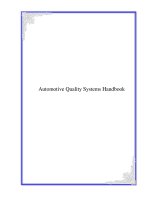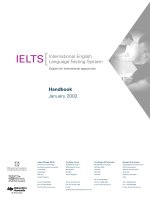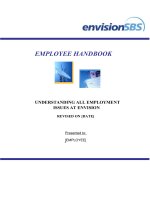EHLE PROJECT TRAINING TOOLKIT: HANDBOOK ppt
Bạn đang xem bản rút gọn của tài liệu. Xem và tải ngay bản đầy đủ của tài liệu tại đây (2.18 MB, 52 trang )
EmpoweringHealthLearningforElderly(EHLE)
2
Handbook
EmpoweringHealthLearningforElderly(EHLE)
3
PARTNERS:
RegionedelVenetoULSS16,Padua(Italy),
Uncass–NationalUnionofCommunalCentresforSocialAction(France),
PermanentUniversityoftheUniversityofAlicante(Spain),
EMGOInstitute,VUUniversityMedicalCenter,Amsterdam(TheNetherlands).
Editors: Chiara Petrolito, Claudio Casotto, Concepción Bru, Maria Chiara Corti, Nuria Ruiz, Giel
Nijpels,
GiorgiodeGobbi,LauraThorogood,LauraWelschen,KristineStempien.
Authorsofthetextsbyareas:CarlosPuerta&AlfonsoSoler(NutritionandGerontology);GiuseppeSergi
& Flavio Varotto (Nutrition); Christian Loison (Nutrition, Physical activities, “Daily Addictions”) Lylian
Vega,JuanTortosa&JuanM.Cortell(PhysicalEducation)andMaurizioSchiavon
&VincenzoMalatesta
(Physical Activity); Alberto Plaza & Antonio Vallés (Psychology); Encarna Gómez & Myriam Cano,
Umberto Gallo & Sandra Scapolo (Pharmacology); Antonio López, Víctor Sarrión & Abel Villaverde,
Claudio Casotto & Laura Bracconeri (Statistical and Graphical Treatment); Caterina Angelini & Cosimo
Guerra (Tobacco Consumption); Stefano Ivis & Maria Assunta Longo
(Patient Communication); Gilles
Vangrevelynghe (Communication and Emotional health); Anna Galiazzo & Elena Chinellato (Emotional
Health);LauraWelschen&GielNijpels(TheoriesandTools).
Translation:LauraThorogood,VíctorM.PinaMedina&UNCCASStaff.
The European project Empowering Health Learning for the Elderly (EHLE) was cofinanced by the
EuropeanCommissionaspartoftheGrundtvigLifeLongLearningProgramme.
The opinions expressed in this document have not been adopted or approved by the European
CommissionanddonotreflecttheCommission’sofficialposition.
TheEuropeanCommissiondeclinesall
responsibilityfortheusestowhichthepresentdocumentmaybeput.
This work has been released under the license Creative Commons AttributionNoncommercialNo
Derivative Works 2.5. To read a copy of the license visit the
website send a letter to Creative Commons,
171SecondStreet,Suite300,SanFrancisco,California,94105,USA.
EmpoweringHealthLearningforElderly(EHLE)
4
Presentation
The Veneto Region government and the ULSS (PCT) 16 have taken part in the European
GrundtvigLifelongLearningProgramme.Thisinitiativetakes concreteforminthe MultimediaTraining
ToolkitproducedbytheEHLE (EmpoweringHealth Learninginthe Elderly)Project. TodaytheTraining
Toolkitwillbepassedon
tothecitizensofItaly,Spain,HollandandFrance,thefourEuropeancountries
whohavecollaboratedontheproject.
The institutions involved in the EHLE project are many and varied, from Universities to Local
AssociationstoPCTs.Theyhave workedtogether togive voiceto theirexperiences,gained fromtheir
daily work with elderly people and in social action through which people and communities take
responsibilityfortheirown
health.
TheaimofthisTrainingToolkit,(producedinEnglishaswellasthefourpartnerlanguages),isto
provide uptodate and portable instruments for communication, training and education for health,
primarily for professionals and others who work daily with elderly people. The acquisition of
responsibilityforandunderstanding
ofone’sownhealth,lifestyleandqualityoflife–empowerment
meansthatthosewhoareawareoftheirhealthrisksandwhowishtochangetheirlifestyles,havethe
knowledgeandtoolsmakepositiveandsuccessfulchange.
Thefutureis,asalwaysinthehandsofourcitizensandpatientsandourroleis,morethanever,
togivevoiceandenergytothepersonalresourcesofeveryoneofthem.Ourroleisalsotocontribute
to the global good which we call ‘Health’, with evermore innovative, sustainable and effective
instruments,bothforoursandfuturegenerations.
In the hope that we will be able to continue our partnership with trusted European partners
suchasthosewithwhomwehaveworkedontheEHLEproject,Iwishyouallsuccessinyourwork.
StefanoValdegamberi
RegionalMinisterforSocialPolicy
SocialandHealthPlanning
VoluntaryandNonProfitSectors
VenetoRegion
FortunatoRao
DirectorGeneral
AziendaULSS16
Padua
Venice,12November2009
EmpoweringHealthLearningforElderly(EHLE)
5
HowToUsetheHandbook
Index
1. PREFACE 6
2. THEPROJECT 7
3. ACTIVITIES 10
4. CONTEXTOFTHEPERCEPTIONANALYSIS 11
5. THETRAININGCONCEPT 16
a. ConceptualFramework 16
b. MethodologicalTechniques 18
6. TRAININGHEALTHPROFESSIONALS 21
a. CommunicatingwithElderlyPeople 22
b. PersonalRelationshipsandEmotionalHealth 23
c. NutritionandElderlyPeople 28
d. UseofMedicinesinElderlyPeople 30
e. TobaccoconsumptionintheElderly 33
f. PhysicalActivityinElderlyPeople 35
7. TEACHINGELDERLYPEOPLETOLIVEHEALTHYLIFESTYLES 38
a. EmotionalHealth 39
b. NutritionandtheElderly 39
c. UseofMedicinesinElderlyPeople 40
d. SmokingandAlcoholConsumptioninElderlyPeople 40
e. PhysicalActivityinElderlyPeople 41
8. PLANNINGTHECOURSE 42
a. SuggestionsfortheSchedulingoftheCourse 42
b. SuggestionsforTrainersWhoWorkWithGroupsofElderlyPeople 43
9. CONCLUSIONS 45
10. BIBLIOGRAPHY 47
EmpoweringHealthLearningforElderly(EHLE)
6
1. PREFACE
ThishandbookisaguidetousingtheTrainingPackproducedbytheEHLEProject(Empowering
Health Learning for the Elderly), which was developed between 2008 and 2009 in four European
countries: Italy, Spain, France and the Netherlands.It was developed within the Grundtvig Life Long
LearningprogrammeoftheEuropean
Commission.
Thehandbookisaimedatallthoseinthehealthandsocialfieldswho,duringtheirwork,come
intocontactandinteractwitholderpeopleinordertopromotetheirgoodhealthandsocialwellbeing.
Amongthesewethereforeincludedoctors,pharmacists,rehabilitationtherapists,dieticiansand
nutritionists, psychologists, social
workers andhealth and social careworkers.We would notexclude
volunteers,workersinnonprofitorganisations,ortrainersinvolvedintheformalandinformaltraining
ofadultsandtheelderly.
ThesearethepeopletowhomthisTrainingPackisdedicated.TheTrainingPackisdesignedto
be a
flexible multimedia instrument in the communication of health and lifestyle messages within a
process oflifelonglearning, capitalising on ourinnateability to learn throughout life indifferent ways
andwithdifferent effects.Educationis apowerfulroute tosocial promotion,anindispensable toolin
thepromotionofhealthandquality
oflife,thevalueofwhichhasbeenconfirmedbymanystudies.
Inthehope ofhaving createda toolthatwillbeuseful toall thosementioned above,wewish
everyonethebestofsuccesswiththeircontinuingwork.
Wewouldlike to thankall theProject Partners for
theircontribution.TheVenetoRegion and
theULSS(PCT)6ofPadua(Italy),theNationalUnionofCommunalCentresforSocialAction(France),the
Permanent University of the University of Alicante (Spain), and the EMGO Institute, VU University
MedicalCenterAmsterdam(theNetherlands).
We also thank the European commission, DG
Culture, for cofinancing the project within the
GrundtvigLifeLongLearningProgramme.
Weinviteyoutovisittheprojectwebsite
www.ehleproject.eu
whereitispossibletodownload
alltheprojectmaterials.
EmpoweringHealthLearningforElderly(EHLE)
7
Fig.1:Proportionofcitizensaged65yearsinEU
Source:EuropeanHealthForAllDatabase,
WHO/Europe,variousyears(19972004)
2. THEPROJECT
THEGRUNDTVIGPROGRAMME:It’snevertoolatetolearn
Demographic changes in Europe, where
today the over65s make up 16.9% of the
population (Fig. 1) and will make up over 30% by
2025, represent a challenge for all European
countries and require evermore urgent
implementation
of ‘active ageing’ policies, aimed
atthelivesofcitizensbeforeandafterretirement.
The European Commission identified the
priority of the Grundtvig Programme as the
creation of new educational opportunities for
adults and elderly people at risk of social
marginalisationduetotheirearlyexitfromformal
educationandtraining.
Advantages of investment in adult
education include greater chances of more
professionalemploymentandageneralincreasein
social benefits in terms of better health and
individualwellbeing.Researchcarriedoutonolder
elderlypeople hasshown thatthose whoare involvedin learningactivities enjoybetter health,with a
consequentreductioninhealthspending.
It’snevertoolatetolearn:infact,thebetterableoneistolearn,thebetterone’squalityoflife
generally.More and better job opportunities reduced spending on unemployment benefits, better
health,andsoon.
Learning for healthy lifestyles is a key factor
to promote health and quality of life of elderly
people.Itisessentialtohelpelderlypeoplemakebetterchoicesintermsofnutritionandlifestyle,and
in communicating clear and simple messages to help keep them in good health. According to World
Health Organisation data, 50%of disabilities in European
countries could be avoidedwith appropriate
preventionmeasures.
EmpoweringHealthLearningforElderly(EHLE)
8
THEEHLEPROJECT:Whichactivitieswewanttocarryout
Financed as partof the Grundtvig Life Long LearningProgramme of the EuropeanCommunity,
the European EHLE ProjectEmpowering Health Learning for the Elderly – comes from the close
collaboration of four European countries (Italy, France, Spain and the
Netherlands).In particular the
projectaimsto:
• Improvethetrainingofthosewhoworkwithelderlypeople,
• CreateaninnovativetrainingmodelvalidacrossEurope,
• Promotediffusionthroughtheproductionanddistributionoflearningmaterials
• Promotetheexchangeofknowledgeandexperienceinordertoachieve
resultsvalidacrossthefield
oflifelonglearningforelderlypeople.
RESULTS:Whatwewanttoachieve…
The aim of the project is to develop a standardised training concept for the four Partner
countries and the eventual creation of a training toolbox.This should be available for all health and
social care workers and professionals in order to help them communicate directly with older people.
Thisisthereforeadualtrainingtoolboxbasedaroundfivekeythematicareas:foodandnutrition,useof
medicines, physical activity, life habits (smoking, use of alcohol, and other risk factors) and emotional
health.
As
partoftheprojectactivitiesatrainingsessionwaspreparedwhichtrainsparticipantsto:
• Empowerelderlypeopletomakeinformedchoicesintheareasofhealthandlifestyle.
• Developandcommunicateclearsimplemessagesaboutfoodandhealthylifestyles.
THETARGETGROUP:Whowearetryingtoreach…
To empower elderly peopleEHLE intendstowork primarily through professionals (GPs, nurses
and pharmacists)but also through healthand socialcare workers andvolunteerswho work dailywith
elderly people.These are the intended recipients of the multiprofessional training toolkit which the
projectaimstocreate.
EmpoweringHealthLearningforElderly(EHLE)
9
THEPARTNERSHIP:EHLEProjectPartners
The project involves four European countries: France, Italy, The Netherlands and Spain,
representedby:
X VenetoRegionalGovernmentULSS(PCT)16,Padua(Italy);
X NationalUnionofCommunalCentresforSocialActionUNCCAS,Paris(France);
X PermanentUniversityoftheUniversityofAlicante,Alicante(Spain);
X EMGOInstitute,VUUniversityMedicalCenterAmsterdam,Amsterdam(theNetherlands).
EmpoweringHealthLearningforElderly(EHLE)
10
3. ACTIVITIES
PERCEPTIONANALYSIS–ThiswasthefirstactivityoftheProjectandwascarriedoutbythefour
European countries involved.It reveals sociodemographic and health characteristics through a
questionnaireadministeredto1200subjects:patientsaged65andoverinDistrict1ofULSS(PCT)
16in
the Veneto, students aged 55 or over at the University of Alicante in Spain, the over 65s who receive
social care from UNCCAS in France and, in the Netherlands, elderly people who were already
participatinginalongitudinalstudyoftheVUUniversityofAmsterdam.
TRAININGCONCEPT–
BasedontheresultsobtainedfromthePerceptionAnalysis, theSpanish
and Dutch partners created a training system designed to provide new knowledge and skills, both
technical and communicative, to those who work with the elderly.These skills will allow such health
and social workers to better guide and interact
with elderly people, giving them the tools to make
responsiblenutritionalandlifestylechoices.
PILOT TRAINING – The EHLE Training System was then tested in Italy and France in four pilot
training courses (two per country).The general objective of the course was to
promote effective
methodologiesforcommunicatinghealthmessagestoelderlypeople.Morespecifically, bytheendof
the course participants knew the relevant scientific evidence regarding health promotion in elderly
peopleand wereable toemploy themost appropriatemethod ofcommunicationinordertopromote
healthinthetargetgroup.
TRAININGTOOLBOX–Allthescientific,methodologicalandcommunicative
materialdeveloped
duringthecourseoftheprojectandrefinedduringthePilotTrainingmakepartoftheTrainingToolbox.
ThisTrainingToolboxisdesignedtogiveconcreteandpracticalsupporttothosewhoworkorvolunteer
withelderlypeople.
EmpoweringHealthLearningforElderly(EHLE)
11
Fig.2:Agedistributionofintervieweesacrossfourcountries.
4. CONTEXTOFTHEPERCEPTIONANALYSIS
The
PerceptionAnalysisofownhealthandwellbeingwascarriedouton1,200peopleofover55
yearsold.The
questionnaireadministeredincludedquestionstodrawoutsocialanddemographicdata
as well as data on lifestyle including alcohol consumption, use of medicines, dietary habits, smoking,
physicalactivityandthesubjects’perceptionoftheirownemotionalwellbeing.
There is great diversity of
characteristics of the subjects surveyed
in the four countries.
Age distribution
and the level of education vary
enormously and these are reflected in
all the variables examined.These
differences aredueto thefactthat the
surveyed populations are structurally
different: students at the Permanent
University of Alicante in Spain, patients
fromaparticulardistrictfortheVeneto
in Italy,
participants in a longitudinal
study for the University of Amsterdam
in the Netherlands and users of social
servicesforUNCASSinFrance.
Looking at age it is notable that
intheNetherlandstheagerange5564representsalmost70%ofthetotal,andover85’s0%.France,in
contrast,
sees5564yearoldsat17%and‘theolderelderly’at21%(Fig.2).
LevelsofeducationaremuchhigherintheSpanishsample(about43%ofthosesurveyedhavea
degree), medium in the Netherlands and low in France and Italy, where not more than 10% have a
degree.
Anotherfactorthatinfluenceslifestyleistheplaceofresidenceofthosesurveyed.InSpainand
theNetherlandsabout80%ofthosesurveyedcomefromrelativelylargetowns (>50,000inhabitants),
and only 34% from villages and rural areas.In France almost 25% of thosesurveyedcomefromless
denselypopulatedruralareas.
EmpoweringHealthLearningforElderly(EHLE)
12
Fig.3:Smokinghabitsbycountryofresidence.
Fig. 4: Alcohol consumption stratified by
frequencyandcountryofresidence.
Fig. 5: Frequency of physical activity
stratifiedbycountry.
In general the subjects sleep for 68
hours a night (although about half do not
consider their sleep satisfactory).Most do not
smoke or have given up smoking, although Italy
stands out with a higher percentage of active
smokers (18%, Figure 3). Alcohol is consumed
withdifferingfrequencyacro s
thefou countries
(Fig. 4).Different answers were given when
physical activity was measured in terms of the
dailylevelofactivity(Fig.5).
s
r
EmpoweringHealthLearningforElderly(EHLE)
13
Fig.6:Satisfactionwithone’sowndietbycountry.
The perception of one’s own
physical health is, overall, good (60%
positive or very positive and only 5% in
decline, see Fig. 6), a factor probably
influenced by the fact that those
interviewed come from selected
segmentsofthepopulation:studentsata
universityforolderpeopleandthosewho
refer themselves to a health centre.In
fact, among those interviewed only 5%
have difficulty in their Basic Daily
Activities (BDA), a very low proportion
compared the general population at the
ameage.s
Those interviewed are satisfied with their diet and provide the following responses to the
questiononhow
satisfiedtheyconsider mselves tobewiththeirowndiet:the
• Mostofthosesurveyedeatthreemealsaday;
• Eatatleastoneportionoffruitandvegetablesadayand
• Eatmeatorfishtwiceorthreetimesaweek.
Therearealso‘unexpected’statistics,for
examplethat14%eatcoldmealsonadailybasisand23%eat
puddingeveryday.
Consumption of medicines is the section in which the results differ most widely and in which
themostdifferentsituationsemergeineachcountry.Aboutaquarterofthetotalconsumedmedicines
arenot
prescribedbythedoctor(selfprescribedorasrecommendedbyfriendsorrelatives).Only50%
ofthosesurveyedbelievethatamedicineboughtinapharmacywithoutprescriptioncouldbedamaging
andabout20%donotbelievethisispossible.
Notable differences in the quantity and type of medicines consumed
appear across the four
European countries surveyed (Fig. 7). The French groupthe oldest and with the lowest level of
educationresultsasthegroupwhichconsumesmostmedicines(mostfrequentlypainkillers,antihigh
blood pressure drugs and sleeping pills). The Dutch group, the youngest, consumes noticeably fewer
medicines,whilethe
groupsfromItalyandSpainshowverysimilarconsumptioninquantitative terms.
It can be hypothesised that these differences in consumption can also be attributed to differences in
accessibilityandeaseofprescriptionofthesedrugsinthedifferentcountriesandnotonlytopopulation
characteristics.
EmpoweringHealthLearningforElderly(EHLE)
14
Fig.7:Percentageconsumptionofmedicines,bytypeofmedicineandbycountry.
The perception of one’s own mnemonic and cognitive abilities is very different across the
countries but most clearly across the different age groups.Overall subjects mentioned that they had
difficulty in remembering the correct words for things, remembering names of people or where they
had put things, but only rarely
noted that they forgot to pass on important messages or were
disorientedoutsidethehome.Theoldestsubjectmentionedthesesymptomsmostfrequently.
3.12and3.10pointsrespectively)whiletheItaliansandtheFrenchreport
anaverageof2.75
and2.76.
reallydoexistbetweenthedifferentpopulationsoriftheyaretheresultofdifferent
subject roups.
populations with significant and
Inordertoevaluatetheperceptionofone’sownemotionalwellbeingascalewascreated,able
to summarise responses to all the questions in this area.This
scale measures emotional wellbeing
cumulatively(forexample,feelingoneselfuseful,fulloflife,desiretolearn,andmeetingfrequentlywith
friendsandfamily).OnaveragetheDutchandtheSpanishreportthehighestlevelsemotionalwellbeing
(aratingof
These differences, from which it appears that the Dutch and Spanish enjoy greater wellbeing
compared to the Italians and French, can be explained in part by the different characteristics of age,
social status and health across the different groups, and not only by geographical
or cultural factors.
Deeper analysis, eliminating the effects of these potential confounders, could demonstrate whether
thesedifferences
g
In summary,for all fourcountries someimportant determinants foremotional wellbeing were
revealed.Indicatorsof
adherence to goodlifestylesinclude: intensity ofphysical activity, satisfaction
withone’sdiet,andperceivedqualityofphysicalhealth.Thecorrelationbetweenhealthylifestylesand
a better level of emotional health can be traced across all four
EmpoweringHealthLearningforElderly(EHLE)
15
Fig.8:Correlationbetweenaverageemotionalhea scoresandthelevelofsatisfactionwithone’sdiet
lth
increasingeffectasthevariablebeingtracedincreases(eg.inFig.8).
rcountriesdespitedifferentstarting
levelsperhapspromptedbygeographicalandculturaldifferences.
people’ personalandemotionalwellbeing,whethertheyliveinItaly,France,TheNetherlandsorSpain.
Inconclusion,eveninthevarietyofthepopulationssurveyed,fromthedataobtainedemerges
animportanthealthmessageforadultsandelderlypeople.Adheringtoahealthylifestyleisassociated
withameasurableandconsistent
emotionalwellbeingacrossallfou
Ourwork,topromoteinitiativesdesignedtoimprovethelifestylesandhabitsofelderlypeople,
isthereforefully supportedbythe datacollectedfromourelderly citizens.Aswewill see,adopting a
healthy lifestyle is effective not only in reducing the risk of adverse events but also in augmenting
s
EmpoweringHealthLearningforElderly(EHLE)
16
5. THETRAININGCONCEPT
a. ConceptualFramework
The goal of the EHLE project is to empower elderly people to make informed choices in the areas of
health and lifestyle and to develop and communicate clear simple messages about food and healthy
lifestyles.Thisgoalisbasedonthe
“patientempowermentapproach”:toenablethepatient(orinthis
project elderly people) to use their own internal resources and abilities in order to manage their own
health.
The Patient Empowerment Approach became well known in the 1990s and has been defined as an
interventiondesignedto“helpthepatient
todiscoverandemployhis/herownabilitiesinordertotake
controloftheirownhealth”.Thisapproachcomesoutoftheideathat,althoughdoctors,nurses,health
workersandcaregiversareexpertsincures,theindividualiscertainlytheexpertontheirownlifeand
should therefore be given
first decisionmaking responsibility.As a result the provision of healthcare
becomescollaborationbetweenthepersonandthehealthworker.Thelatter’straditionalroleofexpert
advisorislessinevidence.
Thereareseveralstrategiesto increasepatient empowerment.Inthisprojectwebelieve thatwe can
empowerelderlypeople
in3steps:1)bycommunicatingtherisksconnectedtoparticularbehaviours,2)
by motivating them to change and 3) by teaching them how to set SMART (Specific, Measurable,
Achievable,RelevantandTimed)goalsonhowtochangetheirlifestyle.Thesetoolswillbeexplainedin
furtherdetailbelow.
But
why dowethink thatwecan helpelderlypeopleto adoptahealthy lifestylebymeansofapplying
these three steps?The answer can be found in our theoretical framework.The use of a conceptual
frameworkisimportantinprojectsandstudiesthatwouldliketopromotehealthylifestyles
forseveral
reasons.Firstly,a frameworkhelpsto designtheconceptoftheprojectin thesense thattheyhelpto
considerwhichelementsshouldbeincludedintheprojectandwhy.Secondly,itprovidesagoodbase
foranevaluationoftheintervention’sefficiency,methodologyandpracticalimplementation.Thirdly,it
allows others to carry out and improve the same intervention in order to use it in their own specific
context.
Ourtheoreticalframeworkisbasedonthreetheories:TheTheoryofPlannedBehaviour(TPB),theself
regulationtheoryandthesocialnetworktheory.
1) The Theory of Planned Behaviour (TPB)
helps us to understand how energy balancerelated
behaviourismediatedbycognitiveconstruct.AccordingtoTPB,humanactionisguidedbythreekinds
ofconsiderations:a)behaviouralbeliefs:beliefsaboutthelikelyconsequencesofthebehaviourandthe
evaluation of these consequences; b) normative beliefs: beliefs about the normative
expectations of
others and the motivation to comply with these expectations; c) control beliefs: beliefs about the
presence of factors that may facilitate, or may impede the performance of the behaviour, and the
EmpoweringHealthLearningforElderly(EHLE)
17
perceived power of these factors. These beliefs can lead, respectively, to a favourable or an
unfavourable attitude towards a certain behaviour, perceived social pressure, and perceived
behaviouralcontrol,andincombinationtheydeterminebehaviouralintention.Finally,givenasufficient
degree of actual control over their own behaviour, people are
expected to carry out their intentions
whentheopportunityarises.
2) SelfRegulation Model: this theory was elaborated by Leventhal and colleagues and suggests that
individualswill usestrategiesthat arebasedonanunderstandingof theirillnessand newexperiences.
Thetheorydelineatesfivecoredimensionsofillnessrepresentation
(people’sperceptionsofandbeliefs
aboutanillness):
• Identificationofthedisease
• Cause
• Timeline
• Consequences
• Controllabilityintermsofpreventionandcure.
The theory hypothesizes that illness representations are important mediating links between health
threatsandpeople’sreactionstothem.Theprocessisadynamicone
thatchangesinresponsetoshifts
inpatients'perceptions:throughexperienceandfeedbackmechanisms,perceptionscanbeinfluenced.
Interventions that are able to successfully incorporate shortterm concrete feedback and tie these to
action plans are more successful than those where feedback is either greatly delayed or nonexistent.
Thismodel
differsfromothertheoriesinitsemphasisontheroleofemotionincopingwithillness.The
modellinkspeople’sperceptionofadiseasewithselfmanagementbehaviours.
3)SocialNetworkTheoryviewssocialrelationshipsintermsofnodesandties.Nodesaretheindividual
actorswithinthenetworks,andties
aretherelationshipsbetweentheactors.Therecanbemanykinds
of ties between the nodes.According to social network theory the attributes of individuals are less
importantthantheirrelationshipsand tieswithotheractorswithinthenetwork.Withinthisapproach
individualbehavioursareconsideredtodependon the
surroundingnetworkinwhich theseindividuals
areembedded.Thereforethefocusoftheanalysesisnottheindividualactorandhisorherattributes
butthe networkpattern,i.e.itssize, structureanditscomposition.Furthermore,members ofasocial
network control andsanction each other’s behaviour.Indensenetworks of
strongties,the members
controleach othermorethan inopenor sparselyconnectednetworksconsistingofweakerties,partly
becauseinnetworksofstrongertiesmoresanctionpossibilitiesexist.
The firsttwotheories describe theimportance of empowering peopletoadopt a healthy lifestyle.By
providing accessible information on
health risks, patients are likely to change their perceptions,
according to Leventhal’s selfregulation model.As a result, people will change their attitude towards
behaviour change, which is embedded in the Theory of Planned Behaviour.Finally, people might
becomemoremotivatedtochangetheirlifestyleinwayswhichwillreducethe
riskofdevelopingsevere
diseases.Finally, social network theory highlights the importance of paying attention to the social
networkthattheelderlypersonispartof(thenetworkoffriendships,socialandfamilialrelationships).
EmpoweringHealthLearningforElderly(EHLE)
18
b. MethodologicalTechniques
ThemethodologicalbaseoftheEHLEprojectistheBehaviourChange
approachaccordingtowhichitis
possible to induceapatient to change his orherdangerous or unhealthybehaviourbyintervening on
threelevels:
1. COMMUNICATIONOFRISKSconnectedtolifestyle(increaseorimprovethepatient’sunderstanding
oftheproblem)
2. MOTIVATIONtochange;
3. GOAL SETTING: DEFINITION OF SMART
OBJECTIVES (Specific, Measurable, Achievable, Relevant,
Timebased).Forexample“walkthreetimesaweekforthirtyminutes”.Onebeginswithshortterm
objectivesandmovesontolongertermobjectives.
The following is a description of some methodological techniques which can be used to help elderly
peopletochange
theirbehaviour.Allthetechniquesdescribedcanbeadoptedseparately,butareeven
moreeffectiveifusedaspartofathreephaseintervention:CommunicationofRisk,Motivation,Goal
setting.
i.
CommunicationofRisk
It has been demonstrated that people underestimate the risk of developing serious
complications.Furthermore, the health professional’s explanation of the risks is often ineffective,
because these risks are often presented in terms of the percentage of people who will develop such
complications.As a result of this poor communication, people are
not encouraged to change their
lifestyles.This idea is already central in Leventhal’s selfregulation model (1997), based on the
hypothesisthatapatient’sknowledgeofforexample,diabetesanditstreatment,candeterminehisor
her healthmanagement behaviour.Understanding the evolution, cause, consequence and exact
identity of a
disease increases one’s ability to control it.To this end it is important to use effective
methodsofrisk communication,for exampleusing visualrepresentations ratherthan writtenstatistics
andscientific data.Itisalso importanttofocuson thebenefitsofchangingbehaviourratherthan the
negativeconsequencesofnot
doingso(lossofhealth/yearsoflife).
ii. TheMotivationalInterview
The motivational interview (MI) is a brief counselling session designed to increase motivation
and to explore and resolve any ambiguities.In recent years motivational interviews have been an
important technique used in behaviour interventions.The four guiding principles of
motivational
interviews are: express empathy, discover discrepancies, challenge resistance and support self
sufficiency. Expressing empathy consists of providing subjects with a respectful and accepting
atmosphere.Thetechniqueused iscalled ‘reflectivelistening’, generallyconsidered thefoundation of
motivationalinterviewsandrecommendedforthewholecounsellingprocess.
EmpoweringHealthLearningforElderly(EHLE)
19
ThesecondprincipleofMIistohighlightthegapbetweentheperson’scurrentconvictionsand
behaviourandtheirwiderambitions.Whenthepatientrecognisesthesediscrepanciestheyoftenfeela
certaindiscontentwhichmakesitmorelikelythattheywillchange.Differencesarediscoveredthrough
theexplorationof
thevaluesofthepersonandofhowthesevaluesandbehaviourfeedintotheirideal
lifestyle.
The third principle, working on resistance, is based on the idea that a direct challenge to a
person’s resistance to change is counterproductive because it generally renders them defensive and
more resistantto
change.The idea is toinviteconsideration of a newpointof view, nottoimpose it
fromabove.
The person’s self sufficiency and trust in their ability to change a particular behaviour even in
difficultcircumstances mustbothbesupportedwherepossibleastheseareamongthebestpredictors
of
positive treatment results. The person can be supported by emphasising past successes (positive
reinforcement) presenting examples of other people’s success (remodelling) and expressing the
convictionthatthepersoncanchange.
iii.
Goalsetting:ProblemSolvingTreatment
ProblemSolvingTreatment(PST)istheconstructionofaseriesofpracticalactivitiestodealwith
problems.The technique was originally described by D'Zurilla and Godfried, then developed and
perfectedbyD'ZurillaandNezu.PSTcanbedefinedastheautocognitivebehaviouralprocessthrough
which a person seeks effective
solutions adapted to their specific situation.PST has been shown
effectivewithpatientswithdepression,butispotentiallyusefulinthetreatmentofanyillnessinwhich
thepersondealswithmultipleissuesintheirdailylifeandisunsureofhowtodealwiththem.
Forexample,peoplewithcomplex
medicalconditionscanfindPSThelpful,astheyneedtodeal
withmanycomplexproblems.Suchpatientstypicallymustbecarefulwiththeirdiet,lifestyle,physical
activity and medicinetaking in order to regulate their condition.Psychological problems are also
commoninthesepatients.PSTcanhelptoaugmentpatient
capacitytoresolvepsychologicalproblems
in a structured way, increase their faith that they will be able to deal problems in the future and
thereforeimprovetheirselfmanagementoftheircondition.
PSTcanbeconsideredasaseriesofsteps:
1. Explanationoftheinterventionanditsrationale
2.
Definitionandunpackingoftheproblem
3. Selectionofachievableobjectivesforproblemsolving(SMART)
4. Creationofvariouspossiblesolutions
5. Theevaluationandchoiceofsolution
6. Puttingthepreferredsolutionintoaction
EmpoweringHealthLearningforElderly(EHLE)
20
7. Evaluationofresults
AnExampleofProblemSolvingTreatment
To help diabetic patients to change their lifestyle, Dutch nutritionists and nurses have used a
questionnaire which outlines the phases of PST: risk communication, motivation, definition of
objectives.Thepatientswereabletoadoptthistechniquetodefinetheirownobjectives.
1. DEFINITION OF THE PROBLEM: What is the problem? For example smoking, excessive weight, low
levelsofphysicalactivityandsoon.
2. DEFINITION
OF ACHIEVABLE OBJECTIVES: For example “I would like to manage more physical
activity:atleast30minutesofphysicalactivity(measurableobjective)everyday(timebased)”.
3. BRAINSTORMING: Whatare thepossible solutions?Go tothe gym,cycle tothe supermarketorto
work,gorunningwithafriendand
soon.
4. EVALUATION OF SOLUTIONS: What are the advantages and disadvantages of each solution? Seek
the best solution: going to the gym is expensive, cycling to the supermarket is possible but not
realisticbecausetheshoppingistoobulky,goingtoworkismanageablebutnotwhenitrains,and
runningwithafrienddependsonthefriendetc.
5. IMPLEMENT THE SOLUTION: The patient goes home and tries to reach their chosen objective or
“takehomemessage”.
6. EVALUATETHERESULT:Hastheresultbeenobtained?Ifthechosenobjectivesarediscoveredtobe
toodifficulttoachieve,it
ispossibletoredefinethem?Ifinsteaditwastooeasy,theeffortcanbe
increased,forexamplebyaddinganextraactivity(e.g.runningwithafriend).
EmpoweringHealthLearningforElderly(EHLE)
21
6. TRAININGHEALTHPROFESSIONALS
The Target Audience: is ideally between 3035 workers or professionals from
differentprofessionalareas.
TheStructureisgivenbythethreekeyphasesofProblemSolvingTreatment:
1. RISKCOMMUNICATION(ofrisksofunhealthylifestyles)
2. MOTIVATION(tochangebehaviour)
3. GOALSETTING(creatingSMART
objectives)
Equipment: Acomputer, projectorand speakers, multimediaresources,stationery,
andenoughspacetoallowforbothtraditionallecturesandworkinmultidisciplinarygroups
andpracticalactivities.
OtherSupportMaterials:
X PowerPointpresentations
X Relevantmodulevideos
X Brochures(Leaflets)
X HealthDiaryorothersupport
X Bibliography
Organisation
ofEachModule:
Eachmodulelastsatotalof1hourapprox.,dividedintotwoseparatesections:atheoreticallecture(30
minutes approx.) and multidisciplinary group activity (30 minutes approx.).The presentation of the
contentandexercisesisasfollows:
• Introduction(5mins)
• Baseconcepts(5
mins)
• Content:
− Therisksandtheadvantagesofreducingthem(5mins)
− Basicstrengtheningmessages(5mins)
− Objectivesandtechniquesforchange(5mins)
− Video(2mins)
• PracticalActivitywithroleplaysorexercises(20mins)
• Debate,checkingandconclusionsingroupsorinplenary(10mins)
EmpoweringHealthLearningforElderly(EHLE)
22
a. CommunicatingwithElderlyPeople
Objectives–Elucidatethecommunicativestrategieswhichfacilitatecommunicationwithelderlypeople
andmakeitmoreefficient.
Tool–PowerPointPresentation
“COMMUNICATIONWITHELDERLYPEOPLE”
TheoreticalContent:
To educate an elderly person abouthealthit is necessary to understand the difficulties of this
type of communication: a limited attention span and understanding of technical language, limited
consultation time, the presence of prejudices or preexisting knowledge which are difficult to change,
littlemotivationtochange
–ortheopposite,i.e.overlyhighexpectationsofwhattheprofessionalcan
do,etc.
Theelderlypersonwhostandsinfrontofthehealthorsocialworkerisnotacleanslatebuthas
prejudices,convictions,information,habitsandmemorieswithwhichheorsheinterpretsandfiltersthe
messagessenttohimorher.Inordertocommunicatesuccessfullywithanelderlypersonitisnecessary
toconsidersomespecificstrategies.
Language must be adapted to the person listening, but not necessarily simplified.If it is
necessarytouse technicallanguage, remember touse itin context andalways
toask: “Haveyou ever
heardofthis?Doyouknowwhatitmeans?”
Whencommunicatingwithanelderlypersonitisnecessarytoconsiderthateverythingyousay
willhaveaneffectontheirfamily,whocanbeahelporahindranceinachievingtheobjectivesset.
The winning attitude is that of professional knowledgeable communication, avoiding
spontaneous (in the sense of automatic) responses.If you can imagine a video camera which shows
your interaction with the elderly person, we can see that ‘spontaneous’ communication takes for
granted that the person we are talking to has understood.
This assumption opens the way for
misunderstandings, insinuation, misinterpretation and a general decline in the standard of
communication.
Professionalknowledgeablecommunicationischaracterisedbythepresenceofclearachievable
objectives.
In transmitting information one must take into account the ‘baggage’ of an elderly person,
including limited concentration, and giving information
which is acceptable, comprehensible,
achievable, concrete and which is transformable into action.Giving too much information risks
promptingakindof‘deafness’which,paradoxically,reinforcestheoriginalnegativeidea.
EmpoweringHealthLearningforElderly(EHLE)
23
Tobreakdownthewallwhichoftenseparatesthehealthorsocialprofessionalfromthepatient
it isnecessaryto begin by asking what the elderly patient thinks –this sends astrongsignal that the
professionalisinterestedinthepersonandinhisorherpriorinformation.
Make best use of time taking care over the opening communication, facilitating the elderly
person’snarrativewith structuredquestionswhich allow abetterunderstanding ofthe patient’s point
ofviewandpriorknowledge,thusavoidingpointlessrepetition.
“DyingHappy”Onepossibleteachingsupportforthecommunicationmoduleisthesimulation
of a consultation between a GP and a 65 yearold patient who is a smoker, overweight, and with
dyslipidemiaandafamilyhistoryofheartdisease.ShegoestotheGPforacheckup,bringingherlatest
testresultsinwhichitisclearthathercholesterollevelsareevenhigherthanbefore.
Transcriptoftheconsultation:
GP:
I’mafraidyourcholesterolisevenhigherthanthelasttimeIsawyou:didn’tIrecommendyoutake
statins?
PATIENT
:Butyouknowtheymakemefeelill.
GP:
Well,areyoutryingtofollowthedietthen?
PATIENT:
(irritated)Sorry,butwhatdiet?
GP
: We’vespoken about it manytimes:you needtoreduceyour intake of animal fats,use oil andnot
butter…
PATIENT
:But… youknow Icook, I’machef.Myrestaurantistheonenearthe church.Onceyou even
came…Irememberitwelland…youordered…yes,youorderedfriedsoleandyourwifeorderedbattered
fishandthenIthinkyoubothhadthetiramisu.
GP
:Well,youknowyourrestaurantisfamousforitsbatteredfish…onceinawhile…Butlet’scomeback
toyou.Youdon’tdoanyexercise,yousmoke,youhaveapoordiet…
PATIENT:Doctor, mybrotherJohn, yourememberhimright,he wasskinny,tookallthemedicinesYOU
doctorsprescribedhim,didn’teatanotherfriedthingoranothersliceofsausagefromthemomentYOU
doctorstoldhimnottoandhedied,threeyearsago,at45.AndI…I’mnotgoingtoenduplikehim.
IfIhavetodieatleastI’lldiehappy.
Instructionsforgroupwork:
Comment:Thepatienthasyouincheckmate.
Question:Howwouldyoureactatthispoint?
Comeupwithpossibleanswers…
b. PersonalRelationshipsandEmotionalHealth
Objectives
• Getting to know
the impact of emotions on health as well as the importance of emotional
regulation.
• Identifyingthebasicemotionalphenomena(emotions,feelingsandstatesofmind).
EmpoweringHealthLearningforElderly(EHLE)
24
• Perceivingemotionalhealthaspartofalifestylethatcanbedevelopedthroughthe knowledge
andpracticeofcopingstrategies.
Tools–PowerPointPresentation
“PERSONALRELATIONSHIPSANDEMOTIONALHEALTH”
TheoreticalContent:
Whataretherisks?
Itisimportanttoknowhowtohelpanelderlypersonexpressthemselves.Thisisbecausethey
often suffer from hidden or underlying depression which makes it difficult for them to express
themselvesortoverbalisetheirproblems;someevenfeelashamed.For
thisreasonthehealthorsocial
professional needs to seek a point of contact which helps them to talk, for example using ‘neutral’
framing questions (about their family, children, etc): these questions seem neutral but are in fact a
useful way to arrive at the desired information.The relationship between the
elderly person, their
family, and social and health professionals is a fundamental part of any successful strategy.We also
need torememberthat resistance tochangeis a physiologicalaspect ofbeing human (eachone ofus
determines a successful strategy for managing our dailylivesand is reluctant to
change this) and that
thisresistance,anditsattendantnegativeeffects,arestrongerinanelderlyperson.
HowtoMotivateBehaviourChange
Asuccessfulapproachisempowermentoriented,designedtogivethepersonpoweroverhisor
herownlife.Thehealthorsocial professionalneeds tofollowthefollowing
stepsto change:1) know
andunderstandtheproblemandlocateresourcesfordealingwithit;2)help thepersontochangethe
relevant behaviour and to live with the consequences of that change; 3) reinforce and emphasise
successandtheexperiencegainedand4)givethepersonknowledge.Communication
withtheelderly
person is neither confession nor a consolation but a professional communication which uses specific
objectivesandresources.ThepatientprofessionaldialogueshouldfollowthepatternofQuestion(from
the professional), Answer (from the patient), Strategic Paraphrasing that summarises the answer
receivedandchecksunderstanding(fromtheprofessional).
Itisalsoimportanttoaskquestionsintherightwayinordertoensurethattheelderlypatient
isabletounderstandtheinformationgiventothemandtobecomeknowledgeableaboutthechangeto
beeffected.Forthisreasonitisnecessarytofindapointofcontactandthusencouragethepatientto
talk,using‘neutralframingquestionswiththeillusionofanalternative’,forexample:“Doyoueatthree
mealsa dayordoyousometimesskip meals?”insteadof “Areyoueating?”.Thefirstquestionseems
neutralbutisawayofgettingatthedesired
information.Iftheelderlypersonisstillunabletorespond
clearly,beginagain,askingthequestioninsimplertermsinordertodiscovertheirsymptoms.
Thenextstepistofindpositiveexceptionstotheproblempresented,andthesearetobefound
using the elderly person’s own resources (e.g.
“Are there times when this doesn’t happen to you?”).
EmpoweringHealthLearningforElderly(EHLE)
25
Theaimistoprescribeasolutionthatmimicsthepositiveexceptionsandtoinvitetheelderlypersonto
returnandrecounttheirexperiences–thusmaintainingmotivation,promotingdialogue,andsoon.
Paraphrasing allows one to simplify the conversation, checking that both parties have
understood and helping to
map the problem.Avoid asking more questions after listening to the first
replies,asitisimportanttosynthesisewhatyouhaveheardusingthesametermsasweregiventoyou
bytheelderly person(thusminimising resistancetochangeas thepatientwill feelthat thesolutionis
theirs).
Don’tforgettoaddthekeyphrase“PleasecorrectmeifI’mwrong”,toencouragedialogueand
toensurethatthepatientfeelslistenedto–andthatyouhaveunderstoodcorrectly.
The reflective technique isat the heart of the process ofinformingan elderly person: to help
the
patientdiscovertheirownstrategiesandsolutionsusingtheirownlanguage,persuadingthemusing
their own arguments.The intervention must be adapted to the person and to their resources, thus
involvingthemandguidingthemtothediscoveryoftheirownsolution.
Whatobjectivestoset
Framing questions and
paraphrases are selfcorrecting: the therapist does not come with
preconceptions and ready made solutions but adapts his or her own vision to that expressed by the
elderlypersonbylookingattheproblemfromhisorherperspective.Thisistheapproachknownasthe
‘locusofinternalcontrol’,where
controlislocatedwiththepersonandisthusempowermentoriented–
the person is pushed to understand the problems as internal in order to resolve these problems with
solutionswhicharealsointernal.









